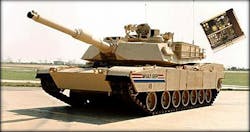Curtiss-Wright lands $2.1 million Army contract for M1A2 Abrams tank embedded fire-control computers
WARREN, Mich., 10 Jan. 2014. U.S. Army armored combat vehicle experts needed embedded computers for ballistic fire control applications aboard the Army General Dynamics M1A2 SEP Abrams main battle tank. They found their solution from Curtiss-Wright Controls Defense Solutions in Santa Clarita, Calif.
Officials of the Defense Logistics Agency's TACOM Life Cycle Management Command (LCMC) activity in Warren, Mich., awarded a $2.1 million contract to Curtiss-Wright this week for 100 Fire Control Communication Processor (FCCP) boards for the M1A2 tank vetronics.
Related: Curtiss-Wright chooses embedded GPS receiver from Rockwell Collins for vetronics networking
Curtiss-Wright has been manufacturing the FCCP boards for the Army and for General Dynamics Land Systems, the M1A2 manufacturer, since 1997, and has delivered more than 4,500 of the boards, Curtiss-Wright officials say. The order is for spare processor boards.
The board accepts data inputs for factors ranging to the tank's speed, uneven terrain, and atmospheric conditions to keep the weapon system's 120-millimeter main gun on target and aiming accurately, even while the tank is on the move.
Related: Rugged Digital Beachhead vetronics networking device introduced by Curtiss-Wright
The FCCP provides increased processing capability and uses the flexibility of PMC mezzanine cards (PMCs) to eliminate a separate card from the fire control electronics unit to reduce system cost and improving reliability, company officials say.
The FCCP boards that Curtiss-Wright is providing to the Army for the M1A2 tank do not represent leading-edge technology, but were designed in to the latest versions of the Abrams tank, and Army officials say no other product can meet the tank's size and technical requirements.
Related: BAE Systems chooses embedded computing from Curtiss-Wright for Bradley vetronics
The Curtiss-Wright FCCP boards are based on the GPCP 750 6U VME single-board computer, designed originally by Vista Controls Corp., which Curtiss-Wright acquired in 2001. At the time of its introduction, the GPCP 750 was one of the first full MIL-STD single-board computers to be based on the PowerPC 750 microprocessor.
The card is designed to operate in temperatures from -55 to 85 degrees Celsius, is radiation-hardened and conduction-cooled, has 512 kilobytes of cache, 32 megabytes of DRAM, 16 megabytes of flash memory, and 512 kilobytes of boot PROM.
Related: Curtiss-Wright to provide turret drive servo system for British Warrior vetronics upgrade
The board was designed not only for fire-control systems like that on the Abrams tank, but also for navigation, flight control, and sighthead stabilization in harsh environments. Army officials say the Abrams tank fire-control system today would be too expensive to redesign to accommodate more modern processor technology.
The Curtiss-Wright GPCP 750 computer boards have on-board resources that include two RS-232 and two RS-422 serial ports, seven variable-gain differential DC inputs, six AC analog inputs, four servo-valve outputs, and five discrete I/O ports.
Related: Vistas mil-spec PowerPC 750-based device rides on Abrams tank
The device also has a high-speed interrupt controller, three 16-bit timers/counters, a watchdog timer and real-time clock along with built-in-test capability, and a JTAG emulation port.
Five-row DIN connectors on P1 and P2, as well as a P0 connector enable all the I/O to transfer through the backplane. All I/O lines are impedance matched to ensure high-quality I/O.
For more information contact Curtiss-Wright Controls Defense Solutions online at www.cwcdefense.com, or the Army TACOM LCMC at www.tacom.army.mil.


